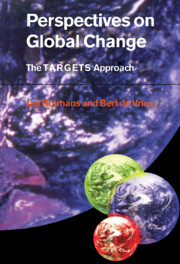Book contents
- Frontmatter
- Contents
- Foreword
- Preface
- 1 Global change and sustainable development
- Part One The TARGETS model
- 2 Concepts
- 3 The TARGETS model
- 4 The Population and Health submodel
- 5 The energy submodel: TIME
- 6 The water submodel: AQUA
- 7 The land and food submodel: TERRA
- 8 The biogeochemical submodel: CYCLES
- 9 Indicators for sustainable development
- 10 Uncertainties in perspective
- Part Two Exploring images of the future
- References
- Acronyms, units and chemical symbols
- Index
6 - The water submodel: AQUA
from Part One - The TARGETS model
Published online by Cambridge University Press: 06 July 2010
- Frontmatter
- Contents
- Foreword
- Preface
- 1 Global change and sustainable development
- Part One The TARGETS model
- 2 Concepts
- 3 The TARGETS model
- 4 The Population and Health submodel
- 5 The energy submodel: TIME
- 6 The water submodel: AQUA
- 7 The land and food submodel: TERRA
- 8 The biogeochemical submodel: CYCLES
- 9 Indicators for sustainable development
- 10 Uncertainties in perspective
- Part Two Exploring images of the future
- References
- Acronyms, units and chemical symbols
- Index
Summary
This chapter introduces the integrated water assessment tool AQUA. This model has been developed to assist policy analysts assessing complex global water problems. A number of major long-term water policy issues are reviewed and AQUA is calibrated and validated against values in the literature. The model has been further validated at the regional level in studies that focus on the Zambezi and Ganges-Brahmaputra river basins.
Introduction
Managing water resources has become an independent field of expertise and a separate domain of public policy. Nowadays, however, many problems of water scarcity and pollution interact with socio-economic development and environmental change to such an extent that a single discipline or sector approach can no longer provide satisfactory solutions. Water flows are purposely being regulated via reservoirs, dikes, canals, and irrigation and drainage schemes. However, runoff is unintentionally being affected by changes in land cover and soil degradation in many parts of the world; future water availability may be affected by climate change; and water pollution is often part of a disturbance of total element cycles. In developing countries, limited availability of clean, fresh water is a major cause of many diseases. The world's food supply increasingly depends on irrigated agriculture and thus again on the availability of fresh water. There is a growing recognition that studies should focus on the interlinkages and feedback mechanisms between water and (other) environmental and human systems (Young et al., 1994).
This chapter discusses an integrated water assessment tool, the AQUA submodel, that has been designed to analyse complex water problems which cannot be understood without adopting a comprehensive approach towards environmental change and socio-economic development.
- Type
- Chapter
- Information
- Perspectives on Global ChangeThe TARGETS Approach, pp. 107 - 134Publisher: Cambridge University PressPrint publication year: 1997

